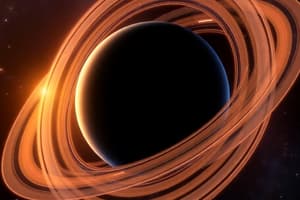Podcast
Questions and Answers
Saturn's rings are composed of __________.
Saturn's rings are composed of __________.
lots of individual particles of ice and rock
Saturn's rings look bright because __________.
Saturn's rings look bright because __________.
light from the Sun reflects off the material in the rings
Which of the following statements correctly describes the motion of the particles in Saturn's rings?
Which of the following statements correctly describes the motion of the particles in Saturn's rings?
- Particles in the inner rings orbit Saturn at a slower speed than particles in the outer rings.
- All the particles in the rings orbit Saturn with the same orbital period.
- Particles in the inner rings orbit Saturn at a faster speed than particles in the outer rings. (correct)
- Particles in all the rings hover motionlessly high above Saturn.
The moon that experiences the most tidal heating is _____
The moon that experiences the most tidal heating is _____
Match the distinguishing geological characteristics to the appropriate moon.
Match the distinguishing geological characteristics to the appropriate moon.
What can you conclude about the tidal force acting on Io?
What can you conclude about the tidal force acting on Io?
Io experiences tidal heating primarily because __________.
Io experiences tidal heating primarily because __________.
How does tidal heating on Europa compare to that on Io?
How does tidal heating on Europa compare to that on Io?
What is the orbital resonance among Io, Europa, and Ganymede?
What is the orbital resonance among Io, Europa, and Ganymede?
Io's elliptical orbit is a result of the orbital resonance among Io, Europa, and Ganymede because __________.
Io's elliptical orbit is a result of the orbital resonance among Io, Europa, and Ganymede because __________.
If a world is subject to tidal heating, we'd expect it to have a __________.
If a world is subject to tidal heating, we'd expect it to have a __________.
What observational evidence confirms that tidal heating is important on Io?
What observational evidence confirms that tidal heating is important on Io?
The tidal force that acts on Io is due primarily to the gravity of __________.
The tidal force that acts on Io is due primarily to the gravity of __________.
Flashcards are hidden until you start studying
Study Notes
Saturn's Rings
- Composed of countless particles of ice and rock, not solid.
- Bright appearance results from sunlight reflecting off icy particles.
Particle Motion in Saturn's Rings
- Particles in inner rings orbit Saturn faster than those in outer rings, adhering to Kepler's third law.
Tidal Heating of Moons
- Io experiences the most tidal heating among Jupiter's moons due to its proximity to the planet.
- Geological characteristics:
- Io: Active volcanoes, visible hot lava, and a source of ionized gas.
- Europa: Evidence of subsurface liquid ocean; ice-covered surface with few craters.
- Ganymede: Largest moon; features heavily cratered terrain beside younger terrain.
Tidal Forces on Io
- Tidal forces vary, strongest when closest to Jupiter and weakest at the farthest.
- Tidal heating on Europa is weaker than on Io.
Orbital Resonance
- Io completes 4 orbits for every 2 of Europa and 1 of Ganymede, causing periodic gravitational interactions.
Effects of Tidal Heating
- Elliptical orbit of Io leads to more pronounced tidal heating, influenced by resonance with Europa and Ganymede.
- Worlds experiencing tidal heating tend to have high internal temperatures due to ongoing internal heating.
Observational Evidence of Tidal Heating
- Active volcanoes on Io serve as evidence of tidal heating, contrasting its size with the non-active Moon, illustrating an internal heat source.
Gravitational Influence
- The tidal force on Io predominantly results from Jupiter's gravitational pull.
Studying That Suits You
Use AI to generate personalized quizzes and flashcards to suit your learning preferences.




